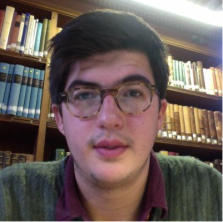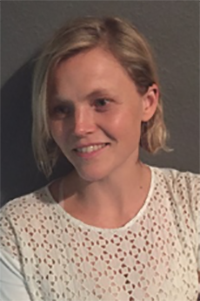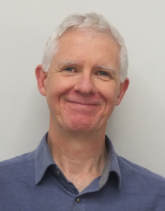Adam Badger
Space, Freedom and Control in the Digital Workplace
Having undertaken both BA Geography and MA Cultural Geography at Royal Holloway, I am delighted to return to the department for PhD study. This time, however, with a twist! As a Leverhulme Trust Magna Carta Scholarship funded candidate I have been given the opportunity to work in a wholly interdisciplinary capacity between the schools of Geography and Management. With my supervisory team – Prof. Phil Crang (Geog) and Prof. Gillian Symons (SoM) – I will be investigating the contemporary digital workplace through a range of analytical lenses. Of particular interest currently are the themes of ‘surveillance, display, and (de)territorialisation’, in addition to the development of methodological toolkits geared toward today’s changing work environments. In this race – both with and against Moore’s law – this line of study will hopefully generate exciting research into digital workplaces and, in addition, build bridges between the disciplines of Geography and Management.
Ed Brookes 
Excavating the contemporary urban geographies of Robin Hood Gardens, London
Before joining the Royal Holloway family I studied at the University of Southampton, graduating in 2013 with a BA in human geography. With a brief interlude for various jobs and travel excursions it wasn’t until 2015 when I returned to academia, enrolling in the MA Cultural Geography course at Royal Holloway. It was during this time, and with great help from the Geography Department, that I managed to secure a PhD with funding by the ESRC. With a start date of September 2017, the PhD (supervised by Dr. Oli Mould and Prof. David Gilbert) aims to explore the social and cultural urban geographies of the Robin Hood Gardens housing estate in East London. More specifically it will focus on how the present-day site, and its on-going political contestation, is continually ‘produced’ by historical and layered assemblages of materiality, culture and urban politics.
In terms of my wider research foci I am particularly interested in the geographies of home, geographies of architecture and concepts of liminality. With a particular fascination with how individuals create and navigate the spaces in which they live as well as how intimate and ‘everyday’ architectural spaces are linked to a wider urban politics. Looking beyond my academic interests, I fill my time with manufacturing unhealthy baked goods and consuming large amounts of dystopian science fiction.
Daniel Crawford

(Dis)Assembling the Sacred
I’ve been a student in the Department of Geography at Royal Holloway since 2012, completing a BA in Geography and MA in Cultural Geography during that time. Funded by an ESRC 1+3 studentship, my PhD aims to investigate how meanings and experiences of sacred spaces are influenced by processes of material change. Within the ‘infrasecular’ present such processes are pervasive, as the relationships between communities and individuals, belief, non-belief and alternative forms of spirituality become increasingly complex, and, in parallel, sacred spaces are transformed and repurposed, made and unmade, neglected and conserved. I am interested in exploring these shifts with reference to various religious and non-religious understandings of the ‘sacred’ itself, many of which offer compelling and provocative ways of thinking about its geographies (architectural, natural, bodily, textual). These inform my current theoretical work looking at how and where silence, nonsense (and non-sense), emptiness and other negative projections of the unknowable might exert themselves. Finding suitable case studies and methodologies to clarify and focus these concerns will be my next step.
Katy Lawn 
Affective geographies of the contemporary British workplace: lifeworlds, biopolitics and precarity
I completed my undergraduate degree at Durham University, where I focused on cultural and literary geographies through a comparative study of Jack Kerouac novels and the philosophy of the (then) recently translated You Must Change Your Life by Peter Sloterdijk. After completing my undergraduate degree in 2013, I worked in a large publishing house for a year – which meant I got to meet David Starkey (very briefly). But the call of the academy was still too strong… and I returned to complete my MA at Royal Holloway in 2016 with a sustained interest in philosophies of living and emotional geographies. My PhD work – supervised by Prof. Phil Crang and Dr. Oli Mould – will carry this interest through with a particular focus on the geographies of work, and within that, the role of affect and emotion in the workplace. I also have an interest in creative methods in social research – for example poetic ethnography and visual methods. When I am not reading critical management theory, I also like to paint, draw, and go to spoken word poetry events.
Flora Parrott

I studied Fine Art at The Michaelis School of Art in Cape Town, The Glasgow School of Art and the Royal College of Art graduating with a Masters in Printmaking in 2009. Exhibitions include, Robin Gibson Gallery in Sydney, Herbert Gallery and Museum in Coventry and the Ryedale Folk Museum, The Cosmos, Residency & Relatively Absolute at Wysing Arts Centre, The Negligent Eye at The Bluecoat, Liverpool, and Thin Place, Oriel Myrddin, Wales. In 2012 I received an Artist International Development Grant to travel to Brazil, the resulting project ‘Fixed Position’ showed at Tintype London, Projeto Fidalga, São Paulo and in The Earth Science Museum at The University São Paulo.
My teaching experience includes: Lecturer at Norwich University College of the Arts and Senior Lecturer at Kingston University. I am also currently visiting lecturer at UCA, and the universities of Birmingham, Bath and Bournemouth.
In 2016 I was Artist in Residence at RGS-IBG and The Leverhulme Artist in Residence in the Geography Department at Royal Holloway University London, developing a project titled ‘Swallet’. Current projects include a publication with Camberwell Press and an upcoming group show at Norwich Castle Museum.

Historical and contemporary performance of cross-cultural first contact encounters: temporal and spatial dynamics
As first year AHRC-funded PhD student, I focus on re-performances of first-contact encounters in colonial-indigenous relationships. My research explores the roles of these encounters and their subsequent expressions in a range of media and contexts, such as neo-historical novels, dance/theatre, oral traditions, and exhibitions, including in the contemporary world. Seen through the lenses of performance and performativity, the research aims to understand the role of first contact re-performances in the cross-cultural dynamics of contemporary societies. I am supervised by Felix Driver and advised by Helen Gilbert.
A ‘Surgeon’ since undertaking an MA in the department 2014-15, I particularly enjoy the interdisciplinary nature of surgeries. Interdisciplinary, eclectic, curious, these are all words that seem to characterise my life; so far anyway. As a public/third sector project manager for 20 years, I worked on such diverse projects as the creation of a long-distance footpath between Winchester and Mont Saint Michel, funding Gaelic language tourism in Scotland, looking for life on Mars, and organising a multicultural percussion festival in the mountains of France. I taught geography, junk percussion and creative writing in both France and in UK Steiner schools over four years, and am also currently working (very) part-time as project co-manager, modern maps processing at the British Library.
My other interests include samba-reggae, photography, knitting, garden design, drawing, theatre, world music, walking and badminton.
Joy Slappnig
The Indigenous Map




